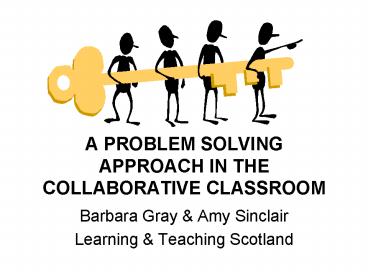A PROBLEM SOLVING APPROACH IN THE COLLABORATIVE CLASSROOM - PowerPoint PPT Presentation
1 / 31
Title:
A PROBLEM SOLVING APPROACH IN THE COLLABORATIVE CLASSROOM
Description:
I've also noticed they are far better at co-operating and working together. ... 'Young people often engage in co-operative learning and discussion with other learners. ... – PowerPoint PPT presentation
Number of Views:44
Avg rating:3.0/5.0
Title: A PROBLEM SOLVING APPROACH IN THE COLLABORATIVE CLASSROOM
1
A PROBLEM SOLVING APPROACH IN THE COLLABORATIVE
CLASSROOM
- Barbara Gray Amy Sinclair
- Learning Teaching Scotland
2
A PROBLEM SOLVING APPROACH IN THE COLLABORATIVE
CLASSROOM
To emphasise that problem solving is
fundamental to good learning and teaching in all
aspects of mathematics and its applications,
problem solving will be addressed within all
lines of development rather than appearing as a
separate element. Building the
Curriculum 1
3
A PROBLEM SOLVING APPROACH IN THE COLLABORATIVE
CLASSROOM
The curriculum needs to include space for
learning beyond subject boundaries, so that
learners can make connections between different
areas of learning. Through interdisciplinary
activities of this kind, young people can develop
their organisational skills, creativity, teamwork
and the ability to apply their learning in new
and challenging contexts. A Curriculum for
Excellence Progress and Proposals
4
A PROBLEM SOLVING APPROACH IN THE COLLABORATIVE
CLASSROOM
- Problem Solving Attributes
- Have a go attitude
- Making links
- Teamwork
- Accept setbacks as learning
- experiences
- Take calculated risks
- Independent learner
- Perseveres
- Self-motivated
- Flexible
- Creative and resourceful
5
Skills for Scotland A Lifelong Skills Strategy
...plan and organise
...work with others
...solve problems
The ability to
...think critically creatively
...use initiative
...lead
...to learn
...take risks
The Scottish Government, Edinburgh 2007
6
9 out of 10 companies believe that soft skills
are as important as academic qualifications. TES
Nov 1997
7
A PROBLEM SOLVING APPROACH IN THE COLLABORATIVE
CLASSROOM
- Approaches to Learning and Teaching
- Allow for choice
- Encourage independence
- Give children ownership
- Encourage children to explain their thinking
- Provide meaningful, relevant contexts, including
the - world of work
- Help children to make connections
- Embed principles of AifL
8
A PROBLEM SOLVING APPROACH IN THE COLLABORATIVE
CLASSROOM
9
A PROBLEM SOLVING APPROACH IN THE COLLABORATIVE
CLASSROOM
Practical Applications of Contextualised Teaching
10
A PROBLEM SOLVING APPROACH IN THE COLLABORATIVE
CLASSROOM
Symmetry is investigated in Artists Corner
11
A PROBLEM SOLVING APPROACH IN THE COLLABORATIVE
CLASSROOM
Pupils use a sand tray to complete work on
co-ordinates
12
A PROBLEM SOLVING APPROACH IN THE COLLABORATIVE
CLASSROOM
Pupils weigh ingredients for a magic spell in
the haunted house
13
A PROBLEM SOLVING APPROACH IN THE COLLABORATIVE
CLASSROOM
Zoo keepers, calculate the feeding times for
animals in their charge
14
A PROBLEM SOLVING APPROACH IN THE COLLABORATIVE
CLASSROOM
Budding scientists measure out quantities of
chemicals in the water tray
15
A PROBLEM SOLVING APPROACH IN THE COLLABORATIVE
CLASSROOM
The Small World area is used to practise
following directions
16
A PROBLEM SOLVING APPROACH IN THE COLLABORATIVE
CLASSROOM
My pupils have a new enthusiasm for maths and
can readily recall concepts that they have
covered in this way. Ive also noticed they are
far better at co-operating and working together.
There were lots of silly squabbles amongst groups
at the beginning but these have not happened for
a long time. The children now work as a team and
learn from each other. Teacher Comment
17
A PROBLEM SOLVING APPROACH IN THE COLLABORATIVE
CLASSROOM
I am not finding that practical maths gives me
any greater workload. On the contrary, the
challenges are quite simple to prepare and set
up, and once this has been done the children are
able to complete them without any teacher help.
There is in fact less preparation (and marking!)
than there is when textbooks and workbooks are
used. Teacher Comment
18
A PROBLEM SOLVING APPROACH IN THE COLLABORATIVE
CLASSROOM
Peruvian Lunch Café
19
A PROBLEM SOLVING APPROACH IN THE COLLABORATIVE
CLASSROOM
The pupils plan the event and how to organise it
as a class
20
A PROBLEM SOLVING APPROACH IN THE COLLABORATIVE
CLASSROOM
Pupils work together to devise a questionnaire
21
A PROBLEM SOLVING APPROACH IN THE COLLABORATIVE
CLASSROOM
Pupils collating the results and display their
findings
22
A PROBLEM SOLVING APPROACH IN THE COLLABORATIVE
CLASSROOM
Measuring the furniture to plan the layout of the
hall
23
A PROBLEM SOLVING APPROACH IN THE COLLABORATIVE
CLASSROOM
Creating scale drawings to work out how to fit
the maximum number of people in the hall
24
A PROBLEM SOLVING APPROACH IN THE COLLABORATIVE
CLASSROOM
Working out how much it will cost so they can
decide how much to charge
25
A PROBLEM SOLVING APPROACH IN THE COLLABORATIVE
CLASSROOM
The pupils prepare the food for their guests
26
A PROBLEM SOLVING APPROACH IN THE COLLABORATIVE
CLASSROOM
The big event!
27
A PROBLEM SOLVING APPROACH IN THE COLLABORATIVE
CLASSROOM
PUPIL COMMENTS
28
(No Transcript)
29
A PROBLEM SOLVING APPROACH IN THE COLLABORATIVE
CLASSROOM
A school is excellent to the extent that......
Young people often engage in co-operative
learning and discussion with other learners.
These activities are designed so that independent
thinking by each learner contributes to the
groups work. Young people build on each others
contributions to reach a common understanding
while respecting minority viewpoints.
Journey to Excellence HMIE March 2006
30
This boy shows great originality which must be
curbed at all costs
Sir Peter Ustinov
31
A PROBLEM SOLVING APPROACH IN THE COLLABORATIVE
CLASSROOM
Contact details Amy Sinclair Barbara
Gray Development Officer Development
Officer Numeracy Curriculum for
Excellence a.sinclair_at_LTScotland.org.uk b.gray_at_LTS
cotland.org.uk 01382 443 640 01382 443
632 0777 577 1357 0777 092 7117































